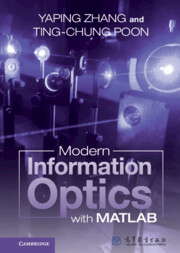Book contents
- Frontmatter
- Dedication
- Contents
- Preface
- 1 Gaussian Optics and Uncertainty Principle
- 2 Linear Invariant Systems and Fourier Analysis
- 3 Wave Propagation and Wave Optics
- 4 Spatial Coherent and Incoherent Optical Systems
- 5 Principles of Coherent Holography
- 6 Digital Holography
- 7 Spatial Light Modulators for Processing Optical Information
- Index
- References
2 - Linear Invariant Systems and Fourier Analysis
Published online by Cambridge University Press: 22 December 2022
- Frontmatter
- Dedication
- Contents
- Preface
- 1 Gaussian Optics and Uncertainty Principle
- 2 Linear Invariant Systems and Fourier Analysis
- 3 Wave Propagation and Wave Optics
- 4 Spatial Coherent and Incoherent Optical Systems
- 5 Principles of Coherent Holography
- 6 Digital Holography
- 7 Spatial Light Modulators for Processing Optical Information
- Index
- References
Summary
The purpose of this chapter is twofold. We will first discuss basic aspect of signals and linear systems in the first part. As we will see in subsequent chapters that diffraction as well as optical imaging systems can be modelled as linear systems. In the second part, we introduce the basic properties of Fourier series, Fourier transform as well as the concept of convolution and correlation. Indeed, many modern optical imaging and processing systems can be modelled with the Fourier methods, and Fourier analysis is the main tool to analyze such optical systems. We shall study time signals in one dimension and signals in two dimensions will then be covered. Many of the concepts developed for one-dimensional (1-D) signals and systems apply to two-dimensional (2-D) systems. This chapter also serves to provide important and basic mathematical tools to be used in subsequent chapters.
Keywords
- Type
- Chapter
- Information
- Modern Information Optics with MATLAB , pp. 21 - 69Publisher: Cambridge University PressPrint publication year: 2023

